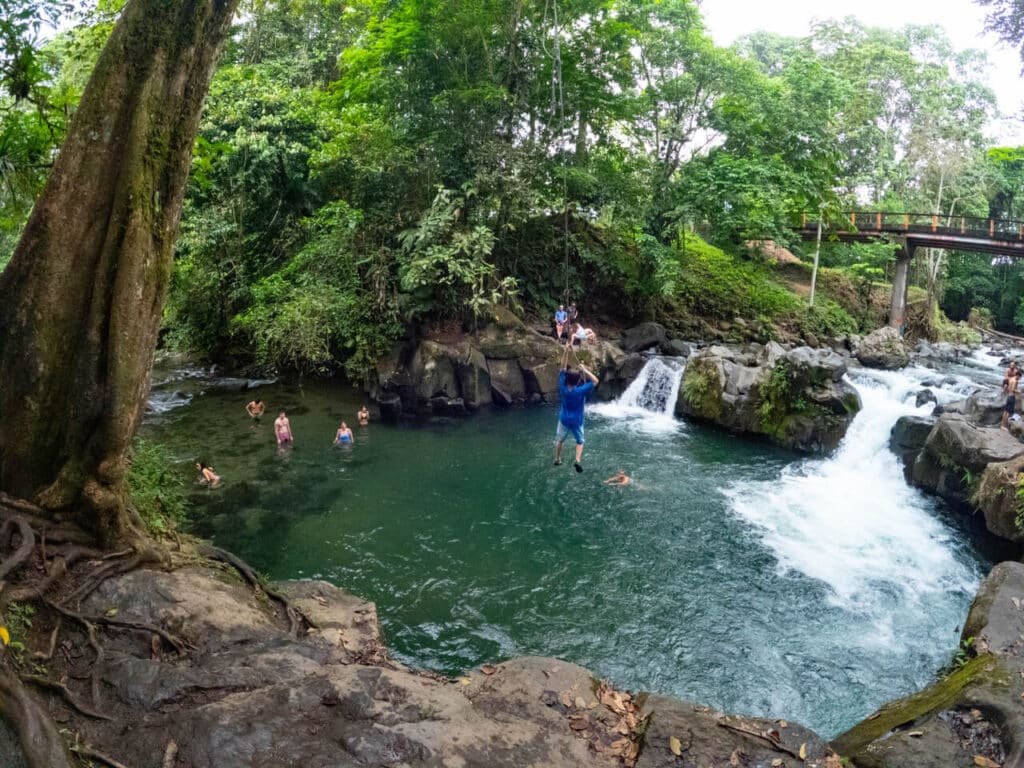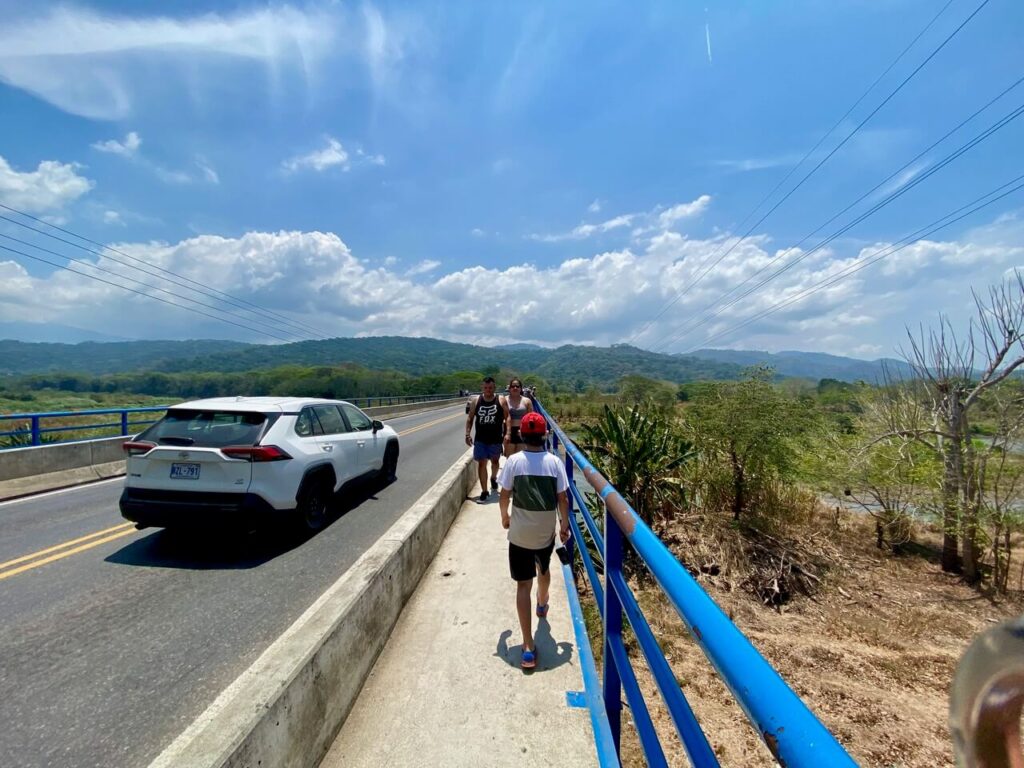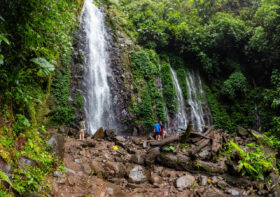DIY Costa Rica: tips for driving and renting a car
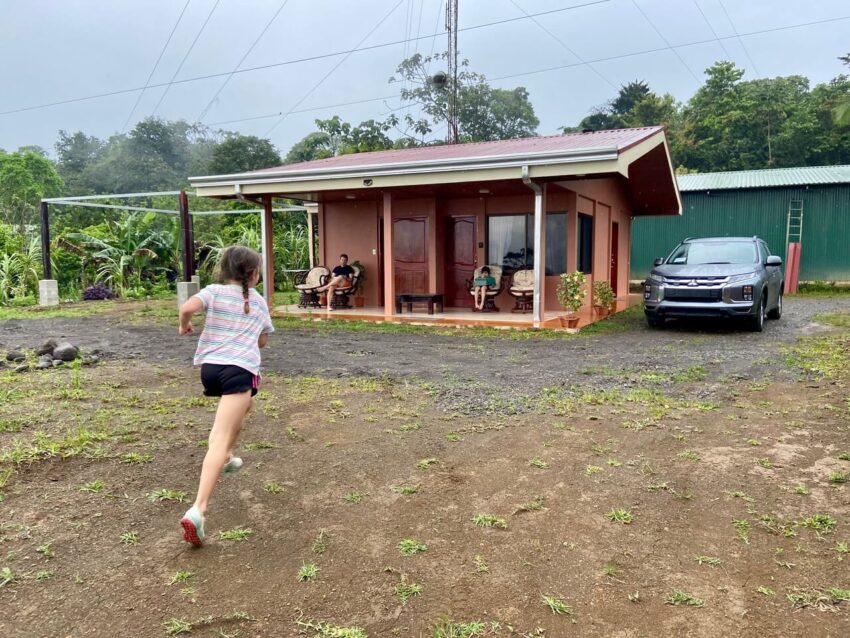
(This, believe it or not, is the only photo we have of our rental car. And chilling in front of our airBNB makes for a very DIY vibe, don’t you think? 😉
If Costa Rica is on your bucket list, but just thinking about planning your trip feels overwhelming – we’ve got you. Costa Rica is, hands down, *THE* most traveler-friendly country we have ever visited. (And one of the most family-friendly, too.) Costa Rica is welcoming. It is accessible. It *gets* tourism. There are many great tour companies and agents that can help you plan an amazing trip to Costa Rica (a highly recommended company we hear about over and over again is Anywhere.com). But there is something to be said for getting to explore the country on your own, taking your time to enjoy the adventures, explore hidden gems, and soak in the Pura Vida vibes. Planning (and executing) your vision of Costa Rica is half the fun!
In this series DYI Costa Rica, we have put together a collection of articles to help you plan your own Costa Rica adventure the trip of a lifetime.
Is driving in Costa Rica crazy?
Honestly, whether you want to do Costa Rica on your own might just come down to whether or not you want to drive.
We had heard so many horror stories of people driving in Costa Rica. Aggressive city drivers. Huge boulders in the middle of a one-lane road. Driving up a mountain with no guardrail. Police that stop you for no reason, looking for bribes.
We experienced *no* horror stories. We found most roads in Costa Rica are paved and well maintained. They are not wide – usually one-lane in each direction. Major highways might be two lanes. The road signs are clear and well marked. Some roads leading directly to attractions or hotels are dirt and gravel, and there definitely can be some hilly driving. The only main tourist destination we visited where the road was unpaved the entire way was the drive to Monteverde (a bumpy 3 hour car ride). The roads are not well lit at night, so we recommend avoiding driving for any length after dark.
We did not spend much time in the city. City driving around the San Jose airport is a mess, but finding the highway is easy, and the roads are quiet if you avoid rush hour.
We came across one police checkpoint, and only needed to show our driver’s license and passport.
With that being said, if I were traveling alone, I would probably choose not to drive. I am kind of an anxious driver, and I don’t see well in the dark. (Daniel, on the other hand, has none of these problems.) But for most drivers comfortable driving in North America or Europe, driving in Costa Rica is not as much of a stretch as people say.
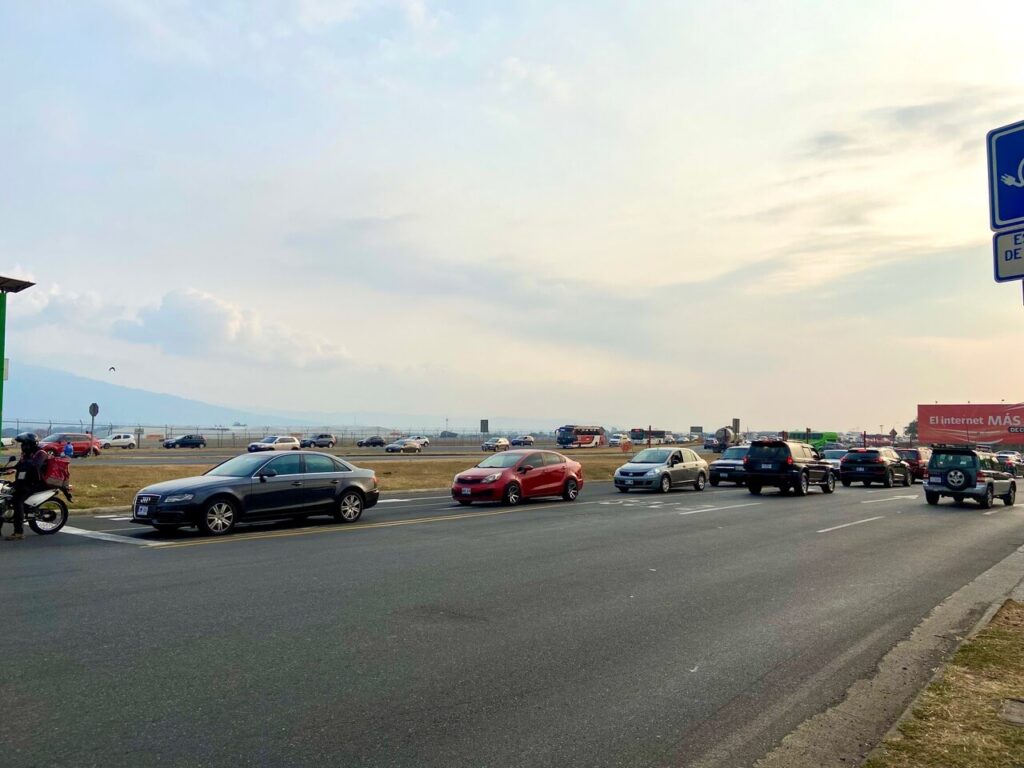
(This is the most chaotic traffic we encountered – this is a city highway right outside the San Jose airport. During rush hour there are cars and aggressive taxis cutting you off and squeezing between lanes.)
Renting a car in Costa Rica
If you have decided to drive and DIY your Costa Rica trip, you will need to rent a car. All you need is your home-country driver’s license, a credit card, and adequate insurance (more on that below).
Cost of renting a vehicle in Costa Rica
We rented an intermediate size 4×4 SUV for our family of 4, and this cost us approximately $1500 USD for 2 weeks.
Do I need a 4×4?
As we said above, you do not necessarily *need* a 4×4 for most places in Costa Rica. However, we strongly recommend it, especially if you are visiting Monteverde. A 4×4 gives you way better traction on those unpaved and hilly roads, where even a short distance can feel like forever. Costa Rica is also constantly rainy, even if you visit during dry season, and having extra control on slippery roads is always helpful. Having a 4×4 gives you peace of mind, and that is huge when traveling.
Where do I rent my car?
Costa Rica has all of the big car rental companies, like Budget, Avis, and Enterprise. It also has a number of smaller independent companies. All “legit” companies offer similar vehicles, and the cost is honestly not that different. We recommend a reputable company, where you have read the reviews and other travellers have given you personal recommendations. This is not a time to pick the cheapest deal. (In fact, this goes for most things in Costa Rica.) Cheaper rental companies often have many hidden fees, and may be unreliable. The last thing you want is to arrive to pick up your vehicle and have your reservation NOT BE THERE.
We rented our car from Vamos Rent a Car. This independent company was highly recommended to us by our friends who used them, and we also read excellent reviews online. We had a great experience with them. Email communication was prompt, the instructions were clear, and we were allowed to check in online before we arrived. Pick up and return was smooth, and the staff were very reasonable. (We did not have any incidents where we needed to call them, but they did assure us they are available 24/7.)
Costa Rica car insurance explained
Third Party Liability (TPL) – approx $15 USD per day. Include this when selecting your car, this is MANDATORY in Costa Rica. (This protects you from injuries and damages to third party property.)
Collison Damage Waiver (CDW) – approx $10 – 20 USD per day, depending on the level of coverage you opt for. This is NOT mandatory, provided your credit card has CDW. (This covers the cost of any damages or theft to the rental vehicle.)
If you choose to opt out of your rental company’s CDW and go with your credit card, be sure to print out your credit card’s CDW policy. Also make sure you book your rental vehicle with this same card. Finally, keep in mind you may need to pay the cost of whatever damage UPFRONT, and then submit this claim to your credit card.
How do I pick up and drop off my vehicle?
Many rental companies will offer shuttle service from the airport or your hotel to the rental centre. Many companies can also deliver the vehicle directly to your hotel (possibly for an extra fee).
If you choose to pick up at another destination, this is possible but will cost money. (For example, people might choose to join a group tour to Tortuguero, since you can’t drive in Tortuguero anyway. You can choose to have your vehicle delivered to you after you are done the tour.)
Add-ons with your car rental
When selecting your vehicle, there are a few things you can add on to your reservation.
Additional drivers – check if your rental company charges a fee if more than one person will be driving on your trip. (Many companies will offer this at no additional cost.)
Car seat – Kids under 12 require a booster seat or carseat in Costa Rica. You can either bring your own, or rent them directly from the rental company. A nice perk if your car rental company offers these for free! (Vamos does.)
GPS/cell phone – many rental companies will offer these for free or a nominal fee per day. This is a good idea even if you are navigating with your phone, in case you ever need a backup.
Ice-box/mini cooler – If trunk space allows, why not? In Costa Rica’s humid weather, it’ll keep your groceries, snacks, and leftovers nice and fresh.
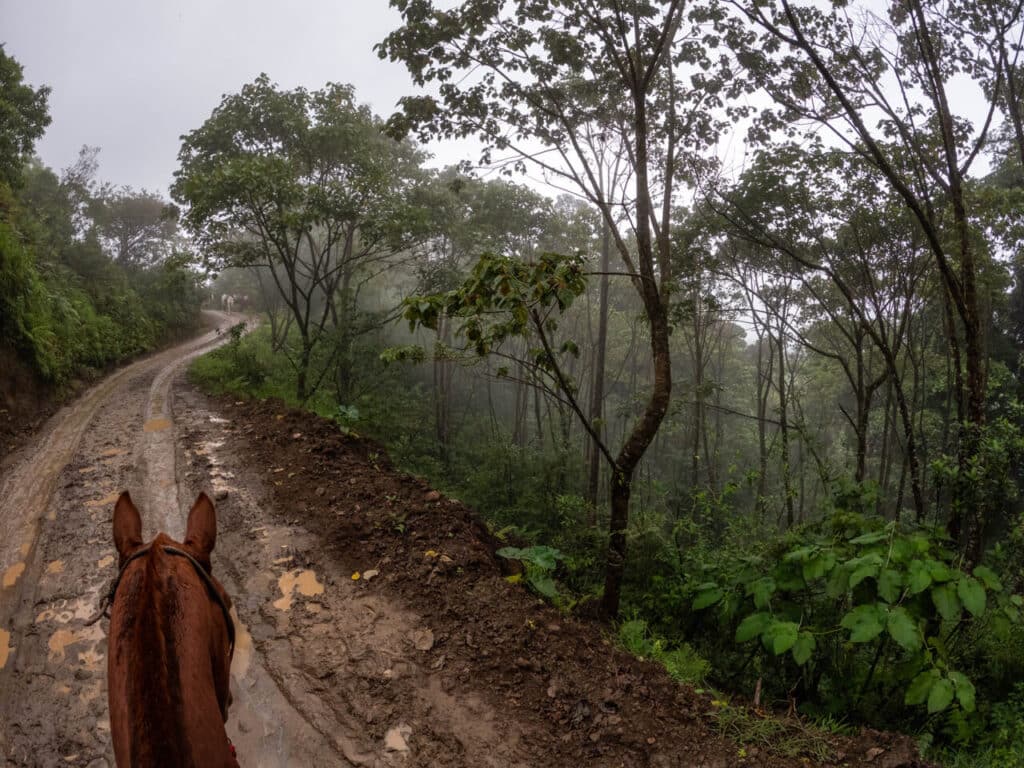
(This is obviously not a car, lol. But this area in and around Monteverde are some of the most challenging roads we encountered. Frequently unpaved, hilly, and wet. However, the views of the cloud forest are completely worth it!)
Picking up your rental car
Arrangements for pick up and drop off
As we mentioned previously, you will need to make arrangements in advance for how you want to collect your rental car. This is usually done via email once you have made your reservation.
You can select to have your rental company send a shuttle to the airport or to your hotel. You can also have the company deliver your car to you for a fee.
Cars need to be returned directly to the rental facility, unless you have made arrangements to have the company pick the car up from you for a fee. Confirm in your agreement whether you need to fill up your gas tank to full, or to whatever amount you started with, (or whether you can bring it back as is). You can also request to have your car hosed down at the gas station for free before returning your vehicle.
Check in and required documents
Check-in can either be done in person, or in advance if your rental agency offers that option. Expect check-in and pick up to take at least 30 mins.
You will need your driver’s license and passport. Any additional drivers need to submit these documents as well. You will also need your credit card, and a copy of your credit card’s collision damage waiver (CDW).
Take copious photos of your car during inspection
Always make sure you do a thorough walk-around and inspection of your car and note down any defects beforehand (you will be paying for this, otherwise!) Take photos of all defects. Ideally, take a video of the staff as they do the inspection.
Tips for driving in Costa Rica
Use Waze
Waze is hands down Costa Rica’s best navigation app. There is even such a thing as the Wazephone (like a GPS, specifically for Waze.) I have no idea why this is, but even Google Maps is consistently outdated and misleading in Costa Rica.
Download Waze. Use Waze. You won’t go wrong.
The “3 hour” rule
This is less of a driving tip than an itinerary planning suggestion. You want to stick to a reasonable distance between destinations, so you don’t feel like you’re driving all day long. Luckily, Costa Rica is a small country, and you can drive between many major tourist destinations in 3 hours-ish (give or take). This includes destinations like:
- San Jose to Arenal
- San Jose to Monteverde
- San Jose to Manual Antonio
- San Jose to Tortuguero
- Liberia to Monteverde
- Tamarindo to Monteverde
- Monteverde to Arenal (the actual distance is only about 17 miles, as the crow flies!)
- Monteverde to Manual Antonio
- Manual Antonio to Osa Peninsula
Try to do most of your driving in the morning
If you want to keep your driving time to the minimum, you want to be driving in good weather. You’ll have the best chance for good weather in the morning. In the afternoons, sometimes fog rolls around (especially near Monteverde). During wet season, it will almost always rain in the afternoon.
Because so many activities in Costa Rica start early (think dawn), you can even fit in a hike or adventure first, and leave for your next destination around mid-morning.
Avoid driving at night
As we mentioned, Costa Rica gets *dark* at night. It makes getting around twisty, unfamiliar roads quite tricky. Getting from your restaurant or your night hike back to your hotel is one thing, but try to avoid driving long distances if you can. Sunset is around 5:30 (winter) to 6:00pm (summer) in Costa Rica.
Always obey the speed limit
Those unscrupulous police we mentioned earlier? Driving over the speed limit is a surefire reason to get pulled over. You will be in for an inflated, hefty fine to get off the hook.
Never leave valuables in your car
Costa Rica is a very safe country on the whole. (So safe, in fact, it is only one of 5 countries in the world not to have a military.) However, be on the lookout for petty crime, including pickpocketing and theft. Try not to leave *anything* in your car at any time, including luggage, bags, and electronics.
Pay someone to watch your car when you park
Many attractions will have fenced and monitored parking lots. If a spot is popular enough and does *not* have paid parking, locals will “step in” as unofficial parking attendants and will watch your vehicle for a fee. This is usually around $4-6 USD. Most of these attractions themselves are free, and paying this small fee with give you easy parking and peace of mind.
Popular spots you may encounter this include:
- Tarcoles River Crocodile Bridge (en route from San Jose to Manual Antonio)
- Playa Espadilla Norte (the locals here are *very* aggressive about watching your car :P)
- El Salto Rope Swing (Arenal)
- Tabacon River hot springs (Arenal, just down the road from the Tabacon Resort)
Keep an eye on your credit card while filling up gas
This is something we had heard through the grapevine. Costa Rica gas stations are full-service. If you are paying with credit card, make sure the attendant brings the machine to you and does the transaction in front of you. (All of ours did. For our 2 week trip moving locations every 3 days or so, we had to fill up 3 times.) This eliminates the chance of any “unsanctioned” transactions that might occur.
